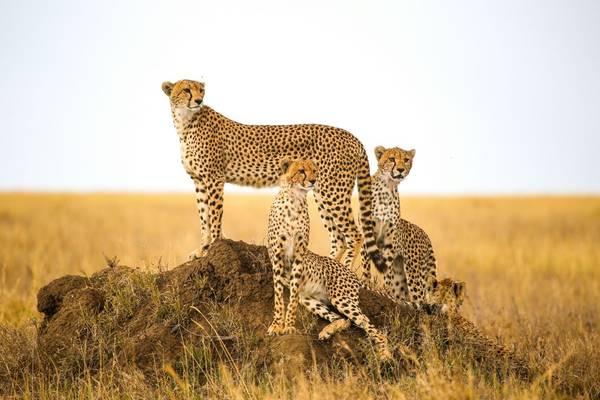Wildlife Holidays in the Serengeti




The Serengeti National Park is one of the world’s greatest wildlife destinations. For most of the year, this vast reserve supports what is perhaps the most awesome spectacle in all of nature: the Great Migration. Following the rains and the growth of fresh grass, vast numbers of Blue Wildebeest, Plains Zebra, Topi and Thomson’s Gazelle, alongside smaller numbers of Common Eland and Grant’s Gazelle, traverse the unbroken plains. It is this sense of endlessness that gives the park its name; ‘Serengeti’ is derived from the Maasai word ‘siringet’, meaning “the place where the land runs on forever”. From a viewpoint atop one of the park’s rocky outcrops, it can indeed feel as if time and space give way, and that you have returned to an era when wildlife still reigned supreme over much of the Earth. No documentary can truly do justice to this magnificence – the Serengeti is a must-visit location for anyone with an interest in the natural world.
Speak with our Serengeti specialist

Our Specialist Recommends
I recommend our ‘Tanzania Highlights’ holiday; a 14-day safari visits 5 distinct national parks; Arusha, Tarangire, Ngorongoro Crater, Lake Manyara and the Serengeti. With over 450 bird species to look for and the great mass of the herbivores and their attendant predators to track down, this holiday provides plenty of interest for bird and mammal enthusiasts alike.
Operations Manager - Paul StanburyThe Great Migration
In the late 19th and early 20th centuries, as Western explorers began to penetrate the savannahs of East Africa, reports started to emerge of a place where animals gathered in scarcely imaginable abundance. The importance of this area was almost immediately recognised, and by 1930 a game reserve was established, covering the eastern and southern parts of today’s Serengeti. Full National Park status followed in 1951, and in 1959 the reserve’s northern boundary was extended up to the Kenyan border. The park was now continuous with the Maasai Mara Game Reserve, and the full extent of the Great Migration had been protected. Today, the Serengeti National Park covers a massive 14,763 square kilometres, and forms part of a much larger continuous ecosystem, which includes the Mara and the Ngorongoro Conservation Area. In recognition of its unique value, the Serengeti National Park was amongst the first places to be proposed as a World Heritage Site, a status it achieved in 1981.
The park is certainly best known for the Great Migration, a natural drama in which around one and a half million Blue Wildebeest, 500,000 Thomson’s Gazelles and 250,000 Plains Zebra travel through the Serengeti’s varied habitats in search of new grazing and fresh water. Although the precise timing of the migration depends on variable rainfall patterns, the herds’ movements are relatively predictable, making it easier for visitors to ensure they are in the right place at the right time. In early November, the short rains fall on the plains of the southern Serengeti, with the animals following by December. Here they tend to stay through the end of March, with most Blue Wildebeest calves being born within a two- or three-week window in February. In April, once the youngsters are strong enough, great columns of antelope begin to stream north. By June, the migration will often have come up against the Grumeti River in the western part of the reserve. Here, large numbers can build up before the herds eventually cross, but as the river is usually made up of isolated channels and pools, most are able to avoid the attentions of predators like Nile Crocodile. From July to October, most of the animals move into Kenya’s Maasai Mara, where they remain until those early November rains again draw them south, and the cycle begins anew.
The Great Migration might appear to be a timeless phenomenon, but there was a period when it was under serious threat. By the late 1960s, a combination of poaching and regular outbreaks of rinderpest had reduced the wildebeest herds to just a quarter of a million. This viral disease also plagued livestock, and there was a campaign to immunise cattle against its effects. Not only was this successful, but it had the remarkable (and completely unexpected) side-effect of causing the disappearance of rinderpest amongst the wildebeest. Happily, since that time the migratory herds have recovered dramatically, providing not just an astonishing spectacle, but also supporting some of the highest densities of large predators on the planet.
Chief amongst these is the Lion. The wider Serengeti-Mara ecosystem is home to over 3,000 of these big cats, with around 2,000 of them making their home in the national park itself. Considering that there may be as few as 20,000 wild Lions left on the planet, it is clear that the Serengeti is a crucial stronghold. While the king of the jungle is hard to miss, its smaller, spotted relative – the Leopard – is usually more elusive. These reclusive felines tend to shy away from open grasslands, preferring to lurk amongst rocks or riverine thickets. Nevertheless, they too are present in healthy numbers.
The Serengeti also provides a refuge for a third large cat, the Cheetah. Of the world’s 33 remaining Cheetah populations, only two contain more than 1,000 individuals; one of these is found within the Serengeti and connected Kenyan reserves. With perhaps just 7,000 of these iconic predators left across their range, the Serengeti is critically important for their conservation. It is here that long-term scientific studies have revealed much of what we know about Cheetahs – for example, the fact that their home ranges can be so vast (some individuals cover over 1,000 square kilometres), or that males, unlike females, are often social.
Another predator, relatively common in the Serengeti, only had its true identity revealed in 2015. For decades, the small, tawny-coloured canine often seen scavenging at kills in the park’s grasslands was thought to be one and the same with Golden Jackal, a species found across parts of Europe, the Middle East and South Asia. However, its DNA reveals it to be more closely related to the Grey Wolf, and thus the Serengeti is now home to the enigmatic African Golden Wolf. It’s a wonderful example of how the park’s extraordinary diversity continues to throw up surprises.
Of course, it is much more than big cats and Blue Wildebeest that brings safari-lovers to the Serengeti, with the park home to around 70 species of large mammal. Among these are African Savanna Elephants, which have recovered from a population low of 500 in 1989 to over 7,000 today. Another species that was hit hard by poaching in the 1960s and ‘70s is the Black Rhinoceros. In the 1980s their numbers in the park barely reached double figures, but sadly their recovery has not been as dramatic as the elephants’; no more than 50 today roam the Serengeti’s areas of thicker bush.
Besides mammals, the reserve also offers some of the most rewarding birdwatching in Africa. Over 500 species have been recorded here, many of them large, conspicuous, colourful and charismatic. Widespread birds that are easily seen include Kori Bustard, Secretarybird, Martial Eagle, Verreaux’s Eagle-Owl and a stunning variety of bee-eaters, rollers, barbets and many more. There are also several specials that are hard to find elsewhere, such as Rufous-tailed Weaver, Usambiro Barbet and Grey-crested Helmetshrike.
It is almost impossible to adequately describe the wonder of the Serengeti. From the scarcely imaginable scale of its migratory herds, through the majesty of its great predators to the raucous abundance of the birdlife, this is a place that must be seen to be believed.



 Loading search...
Loading search...







